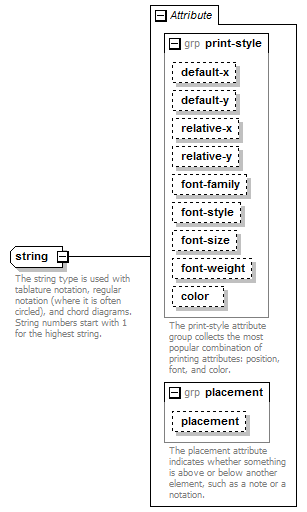string
The string type is used with tablature notation, regular notation (where it is often circled), and chord diagrams. String numbers start with 1 for the highest string. |
Complex Type Information
Model

Attributes
| QName | Type | Fixed | Default | Use | Inheritable | Annotation |
|---|---|---|---|---|---|---|
| color | color | optional | ||||
| default-x | tenths | optional | ||||
| default-y | tenths | optional | ||||
| font-family | comma-separated-text | optional | ||||
| font-size | font-size | optional | ||||
| font-style | font-style | optional | ||||
| font-weight | font-weight | optional | ||||
| placement | above-below | optional | ||||
| relative-x | tenths | optional | ||||
| relative-y | tenths | optional |
Used By
| Elements | frame-note/string, technical/string |
Source
<xs:complexType name="string"> <xs:annotation> <xs:documentation>The string type is used with tablature notation, regular notation (where it is often circled), and chord diagrams. String numbers start with 1 for the highest string.</xs:documentation> </xs:annotation> <xs:simpleContent> <xs:extension base="string-number"> <xs:attributeGroup ref="print-style"/> <xs:attributeGroup ref="placement"/> </xs:extension> </xs:simpleContent> </xs:complexType> |